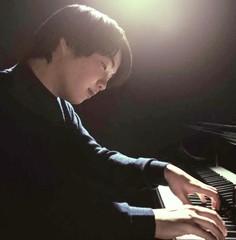|
Back
Breathless! New York
Isaac Stern Auditorium, Carnegie Hall
01/25/2023 -
Wolfgang Amadeus Mozart: Nine Variations on a Minuet by Duport, K. 573 – Piano Sonata No. 9 in D Major, K. 311
Franz Liszt: Ballade No. 2, S. 171
Clara Schumann:Three Romances, Opus 21
Robert Schumann: Piano Sonata No. 2 in G Minor, Opus 22
Mao Fujita (Pianist)

M. Fujita (© Dovile Sermokas)
“I choose the notes that love one another.”
Wolfgang Amadeus Mozart
Carnegie Hall’s balconies were packed (literally) to the rafters last night. Not a seat was empty in the orchestra. Applause turned into screams.
And all for a 24‑year‑old pianist who had never performed in New York, and whose only recording was of the complete Mozart sonatas. Not exactly a best‑seller like Glenn Gould’s Goldberg.
But Mao Fujita is internationally almost venerated. Winner of the Clara Haskil competition, as well as other tests for budding pianists, he has performed with virtually every European orchestra, has given countless recitals, and has a reputation–even for usually blasé Manhattanites–that drew them all to the Hall last night.
The result was mixed, though nobody doubted Mr. Fujita’s absolutely extraordinary fingers. He whizzed through the explosive Schumann Second Sonata with quantum speed. His fingers in the Liszt Second Ballad would have amazed the virtuosic composer himself. And in the two opening Mozart works–pieces ranging from the bucolic to the bubbly–Mr. Fujita ran through the scales with lightning speed.
And just as Mozart’s piano had no pedals, the artist’s digital fluidity was taken with the fingers alone, rarely touching the Steinway levers.
All of which should have been awarded with an unqualified “Whew!”
Except that such dazzling speed is just the start for such a young pianist. Other factors were often in question.
The two opening Mozart works were written at different times, but under Mr. Fujita’s hands they had a merry sameness. The first series of variations on an insignificant minuet theme was superficially simple, but in reality, Mr. Fujita created a blazing series of right‑hand 16th‑note runs. The left hand did its repetitive lines, but for the penultimate variation, Mr. Fujita ran through a blasting semi‑cadenza.
The following Sonata was not so much a contrast as a continuation of Mozart at his happiest, and Mr. Fujita was obviously happy to show off his virtuosity.
For a pianist of slight stature with modest‑sized hands, the following Liszt Second Ballade was not only astonishing: it was a revelation. And easily the most unalloyed satisfactory work of the evening. Written the same time as the B Minor Sonata but one‑half the duration, this was built around almost violent, almost irrational contrasts.
After the Arcadian, Little Mary Sunshine opening, one hardly expected Mr. Fujita to essay such an emotional physically challenging work. Yet from the growling start to the increasingly intense themes, this was simply masterful playing. Pedants might disparage his playing next to the work of Horowitz or Bolet, yet that would be irrelevant, This was a young man who scorned the philosophical or visual facets of the Ballade, and played with a ferocious arousing adoration.
The second half should have been a triumph, except for a quirky decision. He started with three Romances by Clara Schumann. Mrs. Schumann was (for well‑known reasons) a far better performer than her husband. Although she didn’t compose a note after Robert’s madness/suicide. Mr. Fujita proved her prowess as a pianist. The music was not great. The trio of works could have served as efficient, difficult minor works by Brahms or Robert himself. But they did take much dexterity, and while I would have been satisfied with a single Romance, Mr. Fujita played them with fearsome dedication.
The following work was Robert Schumann’s mighty Second Sonata. If nothing else, the first three measures take us out of the Romantic period into a relentless galaxy of notes. Not that the audience heard those notes. For reasons unknown, Mr. Fujita finished the pleasant Romances, and without even a momentary caesura, he launched into the Sonata.
Much of the audience thought this was part of Clara’s music. But ignorance was not as important as Mr. Fujita hiding those tumultuous measures. It would be like Hamlet chatting up Ophelia, raising his head and mumbling “To Be Or Not To Be” before returning to his courtship.
This aside, the Schumann Sonata was an undoubted crowd‑pleaser. Except that the first movement was just that: moving. And breathless. Mr. Fujita took Schumann’s directions literally. The English translation reads “As fast as possible”. The coda reads “Faster”, and the last bars read “Even Faster.”
Not even Erik Satie had crazier directions!!
Yet this movement has brief moments of tenderness, and Mr. Fujita played them with literal care, not very inspired. Speed was the be‑all and end‑all.
The pianist did give a rather tender, even melancholic second movement, followed with an exuberant scherzo. Schumann probably had fun writing it, but Mr. Fujita gave it the serious pendular push. The Finale was breathless. The problem being that Schumann’s work has breath as well as breadth. Methinks that will come in time.
Three encores. Mozart’s oh‑so‑popular K. 545 C Major Sonata. (The audience loved the locomotive speed), an etude (ditto) and...surprise! An early Scriabin etude. Needless to say, when Mao Fujita catches his breath–and holds it–he will be worth those very packed houses.
Harry Rolnick
|